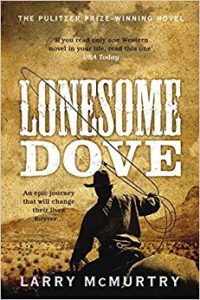

“It’s like I told you last night son. The earth is mostly just a boneyard. But pretty in the sunlight.”
*
“Lonesome Dove is Larry McMurtry’s loftiest novel, a wondrous work, drowned in love, melancholy, and yet, ultimately, exultant.
In Lonesome Dove, as in all of his previous stories, McMurtry lays the hope and despair of ordinary people’s lives side by side. He celebrates a world abundant with calamity and a human spirit wistful but prevailing.
McMurtry’s backdrop is America’s 19th-Century West, a post-Civil War land of cowboys, cattle, sagebrush and myth. That’s hardly a surprise: Today’s West has long been his homeland and the source of his genius. His novels, which include The Last Picture Show and Moving On, have been chronicles of the modern-day frontier, ruminations on how the Old West is slowly—but inexorably—being swallowed by a more mechanical, less romantic civilization. In Lonesome Dove, the chronicler of today’s West turns to yesterday’s West to drink, as it were, directly from his source.
McMurtry’s characters are as attached to the land as they ever will be to each other. The inhabitants of Lonesome Dove, the Texas city from which this story rises, have been born spang into the hands of the land, to wander it and learn the sadness of it until, eventually, it hands them back. ‘The earth,’ remarks Gus McCrae, the novel’s central character, ‘is mostly just a boneyard. But pretty in the sunlight.’

“McMurtry has produced a compelling and memorable epic without sacrificing the fine detail with which he has always worked. This is his strongest, most cogent narrative to date. And that is its triumph.
Gus, white-haired and well-read, is an intellectual on horseback. His partner in the Hat Creek Cattle Co. is Woodrow Call, not as interested in women or conversation as his confederate. Both are aging Texas Rangers, no longer in service, but still possessing all their Rangering skills.
Together, they lead the men of their cattle company plus an assortment of colorful cowhands whom they pick up en route on a laborious drive north, pushing 3,000 head toward the untested and unknown reaches of Montana. On the way, they encounter the wrath of nature: hailstorms, dust storms, snowstorms, swollen rivers, water moccasins, locusts and, of course, Indians. The story is reminiscent of a number of Westerns. The deftness with which it is told is not.

“Throughout this masterful work, there is hope and an understated sense of gratitude. As one cowhand puts it neatly, near death and facing the amputation of his gangrenous leg, ‘It’s a fine world, though rich in hardships at times.’
At the end of the journey, no riches wait. The journey is riches enough.”
–John Horn, The Los Angeles Times, June 8, 1985

